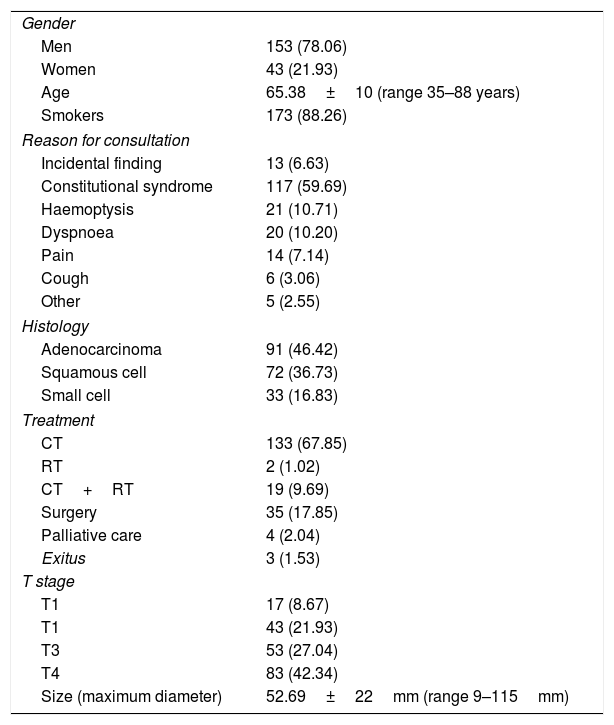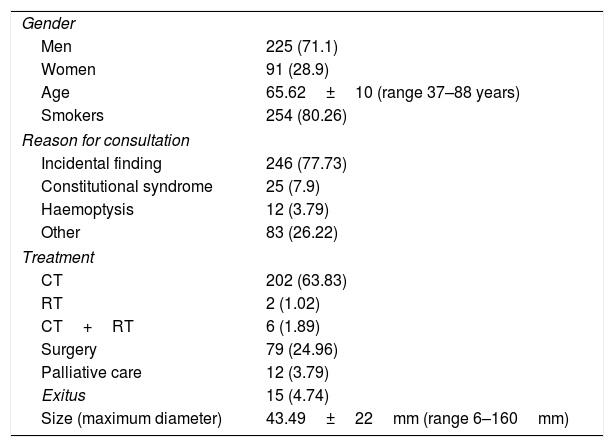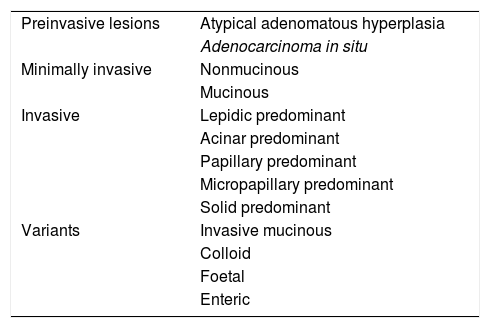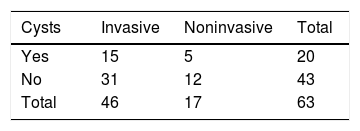To determine the prevalence of pseudocavitation in lung tumors and whether its presence makes it possible to predict the diagnosis of adenocarcinoma with lepidic growth.
Material and methodsWe retrospectively reviewed chest CT studies for 212 consecutive lung tumors included in a CT perfusion database and for 351 consecutive adenocarcinomas diagnosed between July 2007 and September 2017.
Two radiologists blinded to the pathology report determined whether air cysts were present in the tumors, excluding lesions with necrosis and those surrounded by bullae or emphysema.
We analysed whether the presence of pseudocavitation was associated with the histologic type, size, or EGFR positivity of the tumor as well as with the age or sex of the patient. We also evaluated the relationship with the histologic subtype of the tumor in patients who underwent surgery. We used the chi-square test for categorical variables and logistic regression for continuous variables.
ResultsPseudocavitation was present in 15% of the tumors and was significantly more common in adenocarcinomas (24.1%), p=0.003, although it was also observed in 9.8% of the epidermoid carcinomas and in 3% of the microcytic carcinomas. For the diagnosis of adenocarcinoma, the presence of pseudocavitation yielded 92.4% specificity, 24% sensitivity, 73.3% PPV, 58.4% NPV, and 37.6% accuracy.
In the resected adenocarcinomas, 65% of the tumors with pseudocavitation had lepidic growth; the prevalence of pseudocavitation was 40.6% in tumors with lepidic growth, 31.5% in those with acinar growth, and 33% in those with papillary growth. Pseudocavitation was significantly more common in women (29%); no differences were found with respect to age, size, or EGFR positivity.
ConclusionsPseudocavitation is more common in adenocarcinomas with lepidic growth and in women.
Evaluar la prevalencia de seudocavitación en las neoplasias de pulmón y si permite predecir el diagnóstico del adenocarcinoma con crecimiento lepídico.
Material y métodosRevisión retrospectiva de las tomografías computarizadas (TC) de tórax de 212 neoplasias de pulmón consecutivas incluidas en una base de datos de perfusión por TC y de 351 adenocarcinomas consecutivos diagnosticados entre julio de 2007 y septiembre de 2017.
Dos radiólogos recogieron la presencia o ausencia de quistes aéreos en el tumor sin conocer los resultados de anatomía patológica, excluyendo las lesiones con necrosis, rodeadas de bullas o enfisema.
Se analizó si la presencia de seudocavitación tenía relación con el tipo histológico, el tamaño de la lesión y la positividad para el receptor del factor de crecimiento epidérmico (EGFR) del tumor, la edad y el sexo del paciente. También se valoró la relación con el subtipo histológico del adenocarcinoma en aquellos pacientes sometidos a cirugía. Se utilizó la prueba de la χ2 para variables cualitativas y el modelo de regresión logística para variables cuantitativas.
ResultadosEl 15% de las neoplasias presentaron seudocavitación, que fue significativamente más frecuente en los adenocarcinomas (24,1%), p=0,003, si bien también se observó en el 9,8% de los carcinomas epidermoides y en el 3% de los carcinomas microcíticos. Presentó una especificidad del 92,4% para predecir el diagnóstico del adenocarcinoma, con una sensibilidad del 24%, un valour predictivo positivo (VPP) del 73,3%, un valour predictivo negativo del 58,4% y una precisión del 37,6%.
En los adenocarcinomas resecados, el 65% de los tumores con seudocavitación presentaron crecimiento lepídico con una prevalencia del 40,6% en lepídicos, 31,5% en acinares y 33% en papilares. Fue significativamente más frecuente en mujeres (29%) y no se encontraron diferencias en función de la edad, tamaño y positividad para EGFR.
ConclusionesLa seudocavitación es más frecuente en los adenocarcinomas con crecimiento lepídico y en mujeres.

















